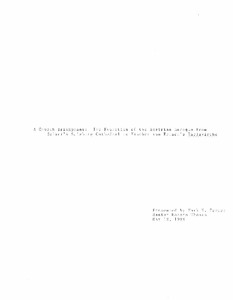| dc.rights.license | In Copyright | en_US |
| dc.creator | Farmer, Mark N. | |
| dc.date.accessioned | 2023-10-20T17:40:36Z | |
| dc.date.available | 2023-10-20T17:40:36Z | |
| dc.date.created | 1988 | |
| dc.identifier | WLURG038_Farmer_thesis_1988 | |
| dc.identifier.uri | https://dspace.wlu.edu/handle/11021/36383 | |
| dc.description.abstract | Political events can directly affect both the development and dissemination of artistic styles. War not only has the power to interrupt the flow of ideas, but it can also affect the very
ideas themselves. The Thirty Years (1) War and the Turkish threat did delay the introduction of the Baroque into Austria in the Seventeenth Century; had it not been for these two political realities, the Baroque would certainly have taken root in Austria in much less time. These wars had even more far-reaching results, however. After the Thirty Years War, Austria knew herself to be firmly in the Catholic camp; following the repulsion of the Turks , the Austrians knew themselves to be world leaders, for they alone had succeeded in throwing back the Ottoman Empire. The confidence and joy resulting from these two events affected the development of the Austrian Baroque itself. The Austrian Baroque emerged in the exuberance of stunning victories over the Turks and with the swelling of national pride. As a result, the style itself is marked by great excitement and exuberance . The style had "a taste for classicity" but "the free spirit of design" (52) as well. Its inherent excitement resulted in curvaceous facades, florid decoration, and inspired ceiling painting. Through are and religion, an Austro-Italian union of sorts was achieved. A Catholic Empire, fully loyal to Rome, emerged, centered around imperial Vienna. The Habsburg monarchy immediately realized the ramifications of its new-found status and sought to glorify itself through art. The triumphal Austrian Baroque style was perfectly suited to such apologetics. So, just as art had once been used to advance the interests of religion, it now came to glorify the state. The Baroque, which had once divided people on religious grounds evolved into a national style, which divided them on political grounds. Austria was entering the European mainstream. The national style was a visual expression of the new national unity. Its unrestrained richness heralded the heights of power and influence to which the Habsburgs were destined. [From Conclusion] | en_US |
| dc.format.extent | 68 pages | en_US |
| dc.language.iso | en_US | en_US |
| dc.rights | This material is made available for use in research, teaching, and private study, pursuant to U.S. Copyright law. The user assumes full responsibility for any use of the materials, including but not limited to, infringement of copyright and publication rights of reproduced materials. Any materials used should be fully credited with the source. | en_US |
| dc.rights.uri | http://rightsstatements.org/vocab/InC/1.0/ | en_US |
| dc.subject.other | Washington and Lee University -- Honors in Art History | en_US |
| dc.title | A Church Triumphant: The Evolution of the Austrian Baroque from Solari 's Salzburg Cathedral to Fischer von Erlach's Karlskirche | en_US |
| dc.type | Text | en_US |
| dcterms.isPartOf | WLURG038 - Student Papers | en_US |
| dc.rights.holder | Farmer, Mark N. | en_US |
| dc.subject.fast | Art, Baroque | en_US |
| dc.subject.fast | Architecture, Baroque | en_US |
| dc.subject.fast | Architecture--Austria | en_US |
| local.department | Art History | en_US |
